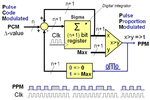CHL
Member level 3
Hello
I wonder why we need an interpolation filter in a digital audio amplifier.
Oversampling can be performed through a digital delta-sigma modulator, so PCM signals from a DSP can be oversampled after the modulator.
Why do we need the interpolation filter in front of the delta-sigma modulator?
I wonder why we need an interpolation filter in a digital audio amplifier.
Oversampling can be performed through a digital delta-sigma modulator, so PCM signals from a DSP can be oversampled after the modulator.
Why do we need the interpolation filter in front of the delta-sigma modulator?
